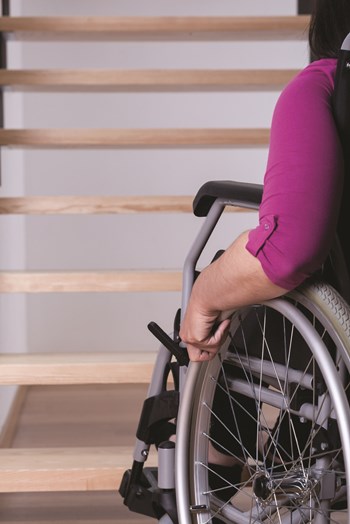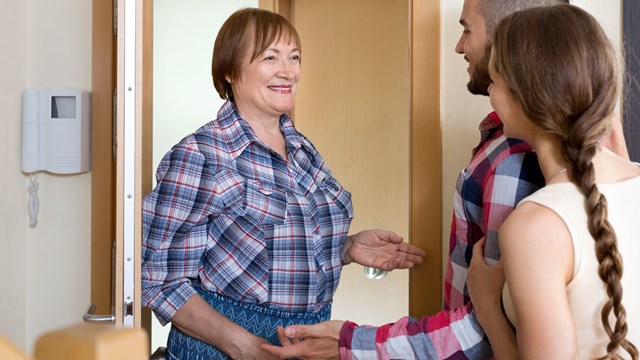
It may be a surprise to some that Chicago is a rather youthful city. Only about 10 percent of Chicagoans are over the age of 65, compared to 13 percent of the entire United States. Forty percent of the city's seniors have a disability, according to the last census—and almost no one considers the multitude of things, from natural disasters to heavy snow storms, that could occur and send their lives into disarray.
It’s not just the elderly either, 10 percent of all Chicagoans, almost 300,000 people, are living with a disability and will likely require additional assistance in the event of an emergency. Then there's the roughly 600,000 young children and teenagers under the age of 18 that also require extra care in an emergency.
Most condominiums, multifamily buildings, and planned communities have policies and procedures in place for emergency evacuations and alerts, but a proactive plan to insure everyone’s safety and security before disaster strikes isn’t static. Annual reviews, updates, and revisions will be required to keep everyone safe, healthy and out of harm’s way. Boards, property managers and the residents themselves all have a role to play in making sure everyone is taken care of in the event of an emergency situation.
Everyone Has a Part
The Red Cross, in their seminal pamphlet on the subject, “Disaster Preparedness for People with Disabilities,” says, “It is important for everyone to be prepared to meet his or her basic needs by storing food and water for a minimum of three days or more,” and those with disabilities “should also be ready to meet your specific disability-related needs by storing sufficient oxygen, medications, battery power, etc., for at least seven days after a disaster.”
That advice should not only be heeded by the disabled but also by the elderly, as many are on some form of medication. It's better to be prepared. “Getting medicine can be so essential for people, so I would recommend using a mail order prescription service, since they’ll send it three months in advance. So that or using a local pharmacy that will deliver for you are things we would recommend,” says Robert Mapes, the director of program and community support at Age Options in Oak Park.
In terms of emergency planning, the Red Cross also recommends creating a supply kit containing food, water, medication, electronic devices and anything else you might need to survive for a few days. They also suggest creating two kits, one for your home and the other for your car. They note that the kits do not need to be made all at once and that you can gather the provisions as you would normally come across them in your daily life, like getting the food and water for your kits when grocery shopping or medications when you see your doctor.
“Older adults and people with disabilities need to have emergency supplies for their personal use for staying in and when they have to flee they should have their medications and other items they would need to survive,” says Mapes.
The Red Cross also suggests that you keep an emergency contact list and a medical list together. For the contact list they suggest listing someone who lives at least 100 miles away, so that they will be outside the disaster zone and easier to reach. For the medical list you should include the medications you are taking and their dosages, the reasons you are taking said medication, and contact information for the doctor who prescribed the medication. This would allow first responders and aid workers to better meet your needs. If you have a hard time communicating, may be helpful to keep a series of note cards with important information on them in your disaster kit.
Families with small children will also want to have a supply of diapers, formula, and personal health items in their emergency supplies.
Animals, be they pets or service animals, should also be taken into account. The Red Cross suggests having a supply of food and whatever medication they may need and note that in the event of a disaster, service animals may be unable to help as they may be too shaken up or frightened. Service animals may pose a bigger problem in evacuations, but a severe storm tends to knock out power and water, but not require an evacuation.
While some may choose to leave until creature comforts can be restored, those who choose to remain will need adequate supplies of canned foods, water, and batteries. When a mandatory evacuation is called for, “hunkering down” at home is not an option.
Formulating a Disaster Plan
“The first thing I really want to mention is that anything you do for the elderly and those with disabilities, you should ask their permission first. You don’t ever want to assume that they want help when they really don’t,” says Mapes.
“So,” continues Mapes, “one of the things we encourage people, even living independently, to do is to have a list of people that need extra help and give it to the fire department. Some buildings also use a buddy system, so those who might be vulnerable have help from others; for example, in the case of a snow storm they can help get them their medicine.”
Managers, board members, and residents also need to be aware of the federal Health Insurance Portability and Accountability Act of 1996, generally known as the HIPAA law. HIPAA is designed to protect an individual’s confidentiality and healthcare information. Without personal authorization, no information can or should be legally shared, even with the best of intentions.
While you can’t compel people to give you the information you might need to be sure they’re taken care of, Sandy Albecker, president of The Enlan Management Team in Chicago, says, “I would think you would know, depending on the size of the building, if someone needed accommodations, if you knew your residents.”
So staying neighborly with residents is one of the easiest ways to figure out if they might need extra assistance. Things like building-wide surveys and asking for disclosures at signing are also options for gathering the necessary information, though you can’t force anyone to answer either.
Once that information is collected, Gene Gaudio, vice president and director of maintenance at Draper and Kramer in Chicago, which provides real estate management, financial management and insurance services throughout the region, advises to keep information in two locations in addition to giving a copy to the local fire department. “This live document is kept in two locations, the property management office and in the main lobby directory. It’s updated regularly, and based on the circumstances of an event, the fire department, in coordination with the building fire manager, will assemble their evacuation plan for those in need of additional assistance.”
“With all of our buildings, the city’s fire department requires that each building assign a person as the building’s ‘fire manager’ with the knowledge of the building layout, egress points, the type of ‘life safety’ systems that are in place in elevator operations, etc. Along with this we maintain in a file a building floor plan of the apartments and public areas,” says Guadio.
Just having a plan isn’t enough though, Karen Berard-Reed, senior project manager at the National Fire Protection Agency in Quincy, Massachusetts notes. There’s no point in having a plan if no one knows what it is. “They could hold fire drills, so people will know how to escape the building or if they can’t where they can be until the fire department gets there. Taking care of snow and ice removal so people have a safe walking path and making sure sidewalks are in good repair [is important].”
“Keeping the area clear of snow is especially important in Chicago,” Albecker adds. “The walks need to be wide enough and clear enough so that individuals with crutches, for example, will be able to have sure footing. It’s not an emergency thing, but it’s something that we need to take great attention to or we’d be doing that person a great disservice.”
“There are a series of requirements that a building must be aware of. In Chicago, building managers and boards need to be proactive with their inspections in the following areas: fire pump testing, smoke detector testing, two-way communication testing, elevator testing, life safety egress and emergency lighting testing, correct directional signage and stairwell markings, safe and clear egress passage, fire extinguisher testing and certification of property improvement and their completions,” says Gaudio.
In addition, Gaudio says, “The American Institute of Architects has requirements directed toward building conditions, such as door swings, door handle types, area of rescue found inside of stairwells, directional signage for the impaired, removal of pathway obstacles, lighting, and audio control devices, among other things.”
Identifying Community Resources
Governmental organizations, such as the Illinois Department of Aging, found at Illinois.gov/aging, and nonprofits like the National Council on Aging will have links to and information about various programs that can be a big help to seniors.
Mapes also recommends Eldercare.gov. It will ask you for your state and zip code, and will let you search by topics, such as fall safety. “For older people, home-delivered meals are a good source of connection for not only meals but also a well-being check on a daily basis,” he adds. So organizations like Meals-on-Wheels are also a big help.
The National Fire Protection Associaton (NFPA) will often team with organizations that visit seniors, or have access to them, and will do fire and fall prevention seminars. It’s possible to set up a seminar for your building through NFPA.org.
Once a board has knowledge of which residents may need special services in the event of an emergency or evacuation, and which community resources match those needs, it's useful to formulate a list of assistance agencies and contact numbers.
The list should be given to all residents along with instructions to be followed in the case of a possible evacuation. This approach allows a board to provide for everyone by encouraging individual responsibility, utilizing community resources, and reducing association and board liability.
Anne Childers is a freelance writer and a frequent contributor to The Chicagoland Cooperator. Staff writer John Zurz contributed to this article.






Leave a Comment